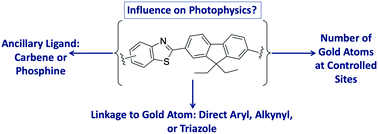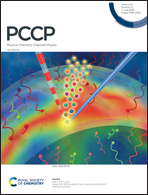Synthesis and photophysics of gold(i) alkynyls bearing a benzothiazole-2,7-fluorenyl moiety: a comparative study analyzing influence of ancillary ligand, bridging moiety, and number of metal centers on photophysical properties†
Abstract
Three new gold(I) alkynyl complexes (Au-ABTF(0–2)) containing a benzothiazole fluorenyl moiety, with either an organic phosphine or N-heterocyclic carbene as ancillary ligand, have been synthesized and photophysically characterized. All three complexes display highly structured ground-state absorption and luminescence spectra. Dual-luminescence is observed in all three complexes at room temperature in toluene after three freeze–pump–thaw cycles. The phosphine complexes (Au-ABTF(0–1)) exhibit similar photophysics with fluorescent quantum yields ∼0.40, triplet-state quantum yields ∼0.50, and fluorescent lifetimes ∼300 ps. The carbene complex Au-ABTF2 displays different behavior; having a fluorescent quantum yield of 0.23, a triplet-state quantum yield of 0.61, and a fluorescent lifetime near 200 ps, demonstrating that the ancillary ligand alters excited-state dynamics. The compounds exhibit strong (on the order of 105 M−1 cm−1) and positive excited-state absorption in both their singlet and triplet excited states spanning the visible region. Delayed fluorescence resulting from triplet–triplet annihilation is also observed in freeze–pump–thaw deaerated samples of all the complexes in toluene. DFT calculations (both static and time-resolved) agree with the photophysical data where phosphine complexes have slightly larger S1–T2 energy gaps (0.28 eV and 0.26 eV) relative to the carbene complex (0.21 eV). Comparison of the photophysical properties of Au-ABTF(0–2) to previously published dinuclear gold(I) complexes and mononuclear gold(I) aryl complexes bearing the same benzothiazole-2,7-fluorenyl moiety are made. Structure–property relationships regarding ancillary ligand, bridging moiety, and number of metal centers are drawn.



 Please wait while we load your content...
Please wait while we load your content...